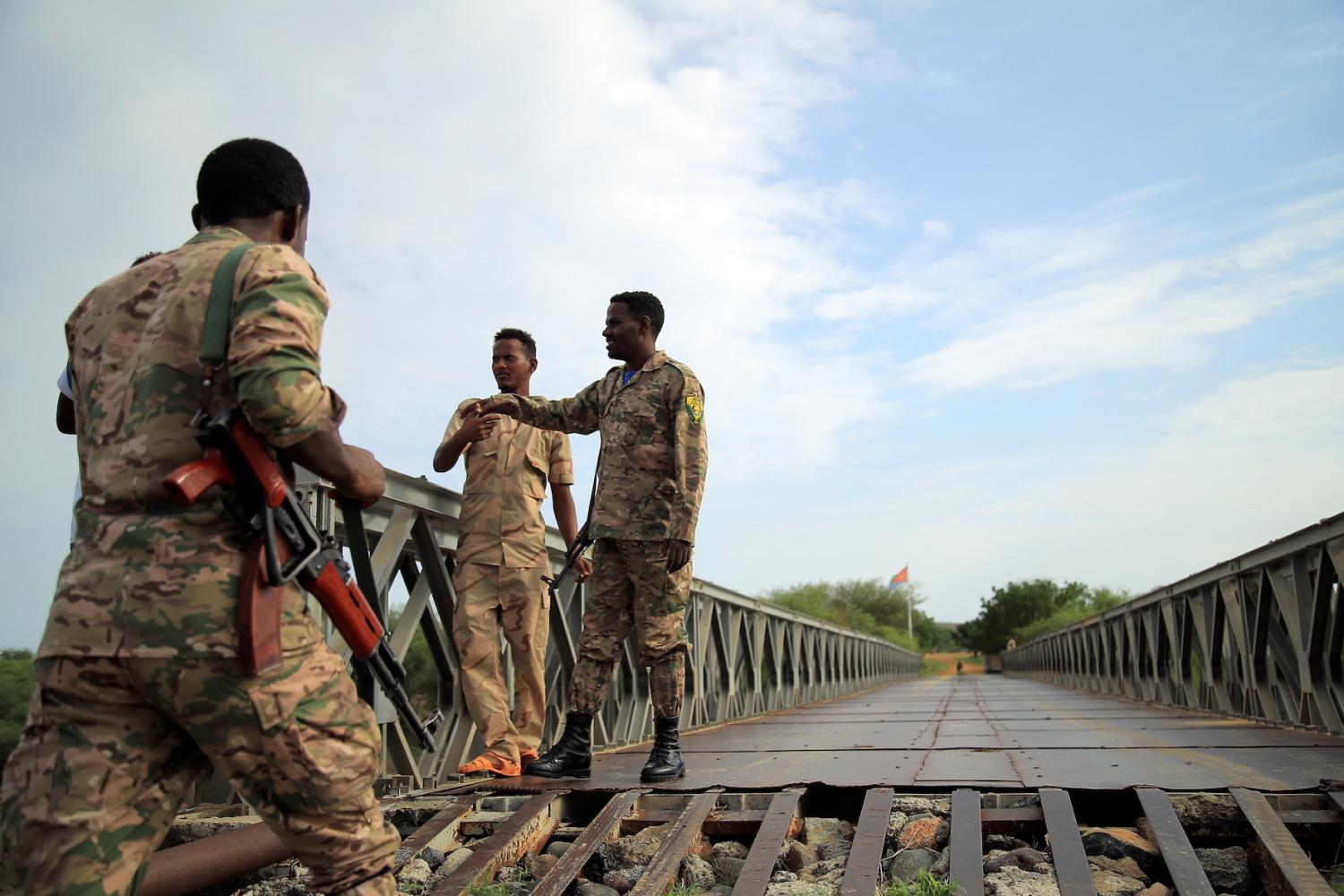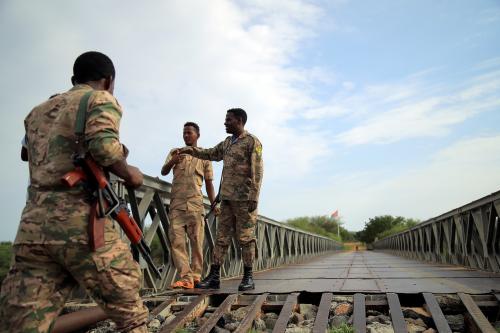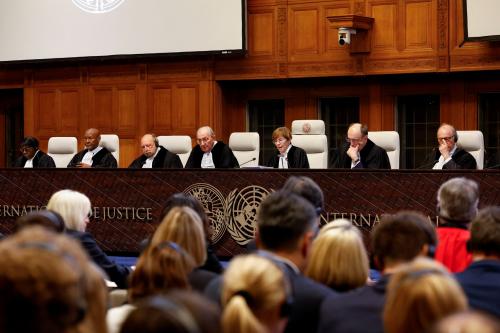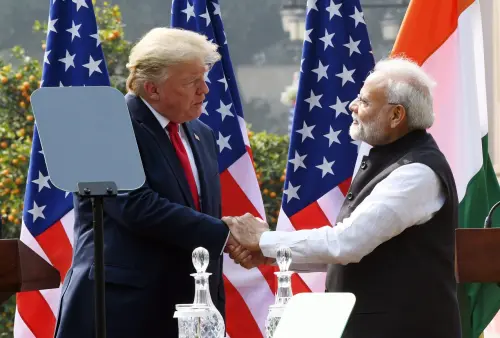This piece is part of a series titled “Nonstate armed actors and illicit economies in 2024” from Brookings’s Initiative on Nonstate Armed Actors.
Russia’s invasion of Ukraine has significantly affected regional illicit economies and criminal networks, but the basic power balance between the Russian state and organized criminal groups has not changed. Due to its direct involvement in illicit economies, the Russian state has remained in a dominant position vis-à-vis criminal groups even as Western sanctions have prompted the emergence of new trafficking routes to supply the industrial and consumer goods that are subject to Western sanctions. This balance of power between the state and crime is likely to continue in 2024, even as Russian citizens’ security starts deteriorating.
In contrast, in Ukraine, Russia’s aggression significantly severed long-established cooperation between Russian and Ukrainian criminal networks. Yet to be seen in 2024 and 2025 is whether Ukrainian criminal groups’ split from their former Russian organized crime partners will persist despite the strong possibility that Ukrainian forces will face increasing attrition in the second half of the year, especially if Western aid falters and dries up.
Relations between Russian and Ukrainian criminal networks
Over the past three decades, Ukrainian organized crime, intensely intermingled with Ukrainian politics and business, was also closely connected to Russian criminal networks. Ukrainian criminal groups were not as tight with their Russian counterparts as the Belarusian crime networks are, but the collaboration was robust enough for Russian intelligence and special forces to use Ukrainian organized crime in support of Russia’s annexation of Crimea and in the separatist region of Donetsk.
Thus, when Russia invaded Ukraine in February 2022, it was uncertain whether Ukrainian criminal networks would sustain their Russian connections or side with Ukraine. Although some Ukrainian criminal groups, such as in Odesa, still provided services to Russian agents, most have severed those ties.
In preparing for the invasion, Russia did not try to line up Ukrainian criminal networks, thinking it would win quickly, Western law enforcement officials told Vanda Felbab-Brown in 2022 and 2023.
The Ukrainian organized groups’ calculations went beyond patriotism: According to Felbab-Brown’s conversations with actors on the ground in Ukraine, experts on Ukrainian organized crime, and Western law enforcement officials, various Ukrainian criminal groups judged that if Russia succeeded in annexing Ukraine, Russian organized crime would eventually subsume or eliminate them. Siding with Ukraine meant preserving some illicit profits and power.
Ukrainian authorities’ early actions reinforced this calculus: First, Ukrainian counterintelligence networks, bolstered by a decade of Western assistance, have systematically and aggressively sought to identify and punish collaborators, including in the criminal underworld.
Second, various Ukrainian politicians and businessmen with criminal entanglements were at least temporarily forgiven if they supported anti-invasion efforts, such as by supplying weapons and ammunition to Ukrainian forces, profiteering along the way. This and broader corruption in Ukrainian procurement, resulting in weapons supply gaps, have created legitimacy problems internally within Ukraine. Ominously, perceptions of corruption could further jeopardize the already-precarious Western military support.
There are also fears that the weapons meant for and being used within Ukraine could leak into European crime markets, but the extent so far has been limited.
Will Ukrainian criminal groups’ pro-Ukraine alignment start changing in 2024? A decline in Western materiel and training support would bring Ukraine to a dangerous military attrition within several months, a trend potentially intensifying in 2025 should Donald Trump win the U.S. presidential election and European right-wing political parties gain momentum. Some Ukrainian organized criminal groups may start determining that defecting and collaborating with Russian actors now may position them better in the long term as battlefield dynamics shift.
Monitoring the criminal landscape and dismantling and arresting any elements of Ukrainian criminal networks developing relations with Russia will be important for maintaining deterrence.
Kremlin-linked sanctions evasion
Following Russia’s 2022 invasion of Ukraine, a second key question was whether Western sanctions would trigger the Russian state to become so dependent on criminal networks for liquidity and crucial goods that Moscow would lose its dominance over organized crime. While a complete meltdown of the Russian state à la the 1990s, when Russian mafia dons-cum-businessmen often dictated terms to Russian officials, was unlikely, a substantial weakening of the Russian state vis-à-vis organized crime was possible.
That did not happen because the Russian state itself handled the sanctions evasion and smuggling of critical goods. The Russian corporate sector managed hydrocarbon sales, since many governments, such as India and Brazil, embraced Russian energy discounts despite Western sanctions. Linking up with North Korea, Iran, and China, Russian special operations and intelligence services established weapons, microchips, and other critical goods pipelines.
North Korea’s mafia government, which operates the country’s illicit economies, has been an important smuggler of weapons into Russia, including artillery shells and missiles. North Korea’s Rason port and Russia-linked rail saw a dramatic surge in container activity after Russia invaded Ukraine. Beyond diplomatic succor, Russia likely pays North Korea back with military technology blueprints, agricultural commodities, and oil.
Through the Caspian Sea, Iranian smuggling networks have similarly delivered anti-tank missiles, RPGs, attack drones, and artillery shells to Moscow, while the Iran-linked Houthis have avoided targeting Russian ships.
China too has played an essential role in undermining Western sanctions on Russia, particularly in vital industrial components like microchips. Russian electronics smuggling rings, such as the Serniya Network, have also helped Russia overcome Western export bans. Establishing front companies in Western countries as well as developing hubs in China, the United Arab Emirates, and Serbia, these channels have supplied both the Russian military and other Russian companies.
China also receives the majority of Russian oil tankers. With the Greek port of Kalamata and the Spanish city Ceuta also implicated in evading the European Union’s ban on Russian oil, Hong Kong and Dubai have become Russian oil companies’ primary trading capitals.
Dubai is also where sanctioned Russian oligarchs and criminals have parked their physical assets and money. Indian smuggling networks operating in Dubai have helped launder Russia-bound money and gold, such as that extracted by the Kremlin-linked Wagner Group.
Kremlin-linked Russian criminal networks are expanding a “dark fleet” of vessels that obfuscate cargo origin and frequently operate without a flag state, registration number, automatic identification system, and insurance. Alternatively, they use flags of convenience such as Panama, Malta, Libera, and Cameroon.
Various Greek companies, such as Navios Maritime Partners and Eastern Mediterranean Maritime, are being scrutinized for Russia-linked transactions. Greek ships now constitute nearly 50 percent of tanker capacity departing from Russian ports, a 33 percent surge since the invasion.
A Bombay-based company, Gatik Ship, facilitates disguising ship ownership and illicit business. After Saint Kitts and Nevis annulled the registration of 36 Gatik ships for transporting sanctioned Russian oil, at least four were reflagged in Mongolia.
New land smuggling routes through Central Asia, the Caucasus, and Turkey have also emerged. Many of these networks are highly fragmented, decentralized, non-Russian, and independent of the Kremlin. But since they mostly carry consumer goods for the Russian economy, instead of sensitive military and industrial contraband, they do not threaten the Russian state’s power.
Long used to collecting “taxes” from Russian crime networks, Russian intelligence services began extensively facilitating and directing the Russian organized criminal groups’ smuggling of counterfeit and untaxed tobacco, other counterfeit goods, and even drugs to generate hard cash for the state and their own covert operations.
Organized crime within Russia
Acting independently of the Kremlin, some Russian organized criminal groups also smuggle Western consumer goods, from Mercedes parts to cat food. Since Russian law enforcement structures are preoccupied with suppressing protest and tracing anti-war activities, they are paying less attention. In time, competition over these markets could trigger fights among Russian criminal groups, creating some legitimacy and deterrence problems for the Kremlin.
However, by satisfying Russian consumers, this growing smuggling also indirectly reinforces the Kremlin’s grip on power. Besides, Russia has copycatted many Western brands, raking in profits, often with the Kremlin’s direct hand. The Kremlin and Russian elites have been able to cash in on the bonanza.
While former Wagner leader Yevgeny Prigozhin pioneered the recruitment of hardened criminals, including murderers and drug smugglers, from Russian prisons for Wagner’s Ukraine operations, the Russian military has picked up the practice. Those who do not become the war’s cannon fodder will eventually return to Russia, significantly augmenting Russian criminal groups’ coercive power and perhaps their proclivity toward violence. The Kremlin will have a challenge keeping them subservient. And while in the ranks, they risk further criminalizing the already-corruption-ridden Russian military.
Russian cybercrime is getting closer to the Russian state
Since February 2022, Russian government-affiliated groups have accelerated denial-of-service attacks and malware operations against Ukrainian cyber infrastructure. Leading the charge has been the Sandworm Team, closely linked to Russia’s military intelligence service and engaging in cyberattacks against Ukraine since 2015. Sandworm also helped bring down various Ukrainian cities’ power grids, but its cybercrime and espionage operations go far beyond Ukraine.
Importantly, various previously-independent Russian cybercrime groups, such as Wizard Spider, which has conducted ransomware attacks against U.S. health care networks, have aligned themselves with the Russian state and joined attacks against Ukraine.
Drug flows
Although the war in Ukraine redirected some drug routes, cocaine smuggling into Russia did not collapse. In fact, the cocaine supply, intended for distribution into Western Europe, appears to have increased, as Russian criminal networks, assisted by counterparts in Lithuania, Belarus, Serbia, and Turkey, continue to supply cocaine from Ecuador, Costa Rica, and Venezuela. And despite the Taliban’s ban on opium cultivation, the Russian criminal networks’ decades-old smuggling of Afghan heroin into Russia and Europe, some of which is linked to groups in Chechnya and its strongman Ramzan Kadyrov, has not shown any weakening either.
But consistent with the synthetic drugs revolution sweeping the world, amphetamine use is also rising in Russia. Synthetic drug laboratories, many owned by Russian organized crime and relocated to Kazakhstan since 2022, supply members of the Russian military.
Russian crime far away from Russia
Russian smuggling networks have also proliferated in surprising places, such as the U.S.-Mexico border where since mid-2022, U.S. Customs and Border Protection has reported a noticeable increase in Russians attempting to cross into the United States. The messaging platform Telegram offers detailed migration guidance and facilitates connections to smuggling networks. Many of the smuggled individuals are likely escaping the Kremlin’s authoritarianism, but amid the intense Russian intelligence presence in Latin America and especially in Mexico, some could endanger U.S. interests.
Russian intelligence services could also encourage the establishment of greater cooperation between Russian and Mexican criminal groups or attempt to develop direct ties to Mexicans by offering them safe haven in Russia away from the reach of U.S. law enforcement. Should any such ties materialize, the United States should prioritize dismantling any Mexican groups collaborating with Russia.
Overall, in 2024, the prospects are high that the Russian state will maintain its upper hand vis-à-vis Russian organized crime, while Ukrainian organized crime may start posing a multifaceted challenge to Ukraine.
The Brookings Institution is committed to quality, independence, and impact.
We are supported by a diverse array of funders. In line with our values and policies, each Brookings publication represents the sole views of its author(s).









Commentary
Russia, Ukraine, and organized crime and illicit economies in 2024
February 6, 2024